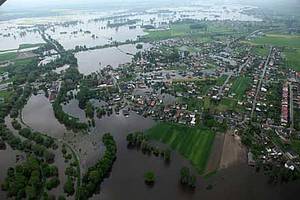
© Krzysztof Konieczny WWF-Poland
Flood retention walls lead to greater damage when breached. Giving rivers room to flood and allowing wetlands to fulfill their function as natural wetlands reduces flood costs
Warsaw, Poland: Poland’s devastating floods have been worsened by over-reliance on flood embankments and over-development of flood plains, WWF-Poland said today.
The global environment group, which has been agitating in Poland for modern systems of natural complementary flood protection since devastating floods in 1997, said it greatly regretted the loss of life of property in current floods.
“But in Poland, despite losses caused every year by floods and appeals from NGOs such as WWF. the same mistakes continue to be repeated over and over again,” said Piotr Nieznański, Head of Conservation for WWF Poland.
“Uncontrolled development of areas at risk from flooding is considered at present as one of the most important causes of mounting economic and social losses resulting from river flooding.
“At the same time, already three quarters of floodplains of the Odra and the Vistula river in Poland have been confined inside flood embankments and open for development even though it is common knowledge that the flood embankments do not guarantee 100% safety to these areas.”
For rivers – space, for humans – safety
During thirteen years which elapsed since the great flood of 1997 WWF published and distributed to local authorities brochure “For rivers – space, for humans – safety”, which emphasises the need for a series of new solutions to improve flood safety. This material was passed to local authorities 8 years ago, after the 2001 Vistula floods.
In developed countries preventing development in floodplain areas is a fundamental rule of flood protection.
Moreover, a legal expert study was sent out to Water Management Boards on the subject of legal regulations which could be used to hold back development in floodplain areas.
The Odra River Floodplains Atlas, developed ten years ago also made it possible to designate areas where water may flood safely without causing damage along the entire course of this river.
In 2007 WWF-Poland, in cooperation with the Regional Board for Water Management Wrocław, developed and passed on to the commune authorities on the Odra information material and maps showing areas at risk from flooding in the Odra valley in the Lower Silesian voivodship.
These were to be taken into account when planning development in individual communes so that the commune authorities would not issue permits for development in areas potentially at risk from flooding.
The majority of these communes declare that they have been using these maps while issuing decisions on development and hold back building construction and project investments from entering areas most threatened by flooding.
In cooperation with local self-governments and state administration WWF has also been running a project which involves setting back some 7.5 km of embankments several score metres from the Odra to help obtain an additional area of around 700 ha where the river could flood without causing damage This should help improve flood safety of two localities which were affected by the 1997 flood and, at the same time, restore the good status of areas valuable for nature.
“It is a pity that Poland does not take advantage of a huge potential for water storage in areas where river flooding does not cause great losses,” said Nieznański. “Designation and appropriate adjustment of these areas in the valleys of Poland’s rivers would make it possible to reduce the threat in areas with development.
“Unfortunately, this has not met with the understanding of the decision makers who continue to believe that merely raising the level of flood embankments or construction of reservoirs will change the situation.”
More and more rivers around the world have been seeing projects to restore wetlands as natural wet and dry season reservoirs, with dramatic reductions in flood damage being only one of the benefits. Other projects have reduced the canalisation of rivers and increased access to flood plains.
“Non-technical programmes on behalf of flood effects mitigation and natural storage preservation ought to be implemented consistently by successive governments,” said Nieznański. “Unfortunately, they continue to be treated marginally even though they are a crucial element for reducing the consequences of flooding.
“We hope that changes announced by the representatives of the highest authorities will guarantee the possibility to purchase land most often open to disaster which will help to resettle inhabitants of these areas to safer places.
“Unfortunately, interest in floods tends to increase only with increase in the level of the flood wave, but let us hope that the latest developments will force the politicians to make true the promises of a comprehensive renovation of the flood protection system”
SOURCE: http://www.wwf.or.th/wwf_news/?193432/Flood-plain-failures-lead-to-tragedy-in-Poland
|

